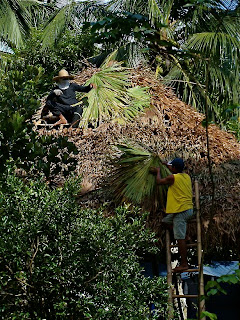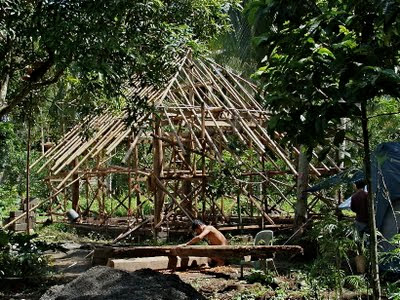 |
| Still-fresh anahaw leaves right after installation. |
It wasn't until end-April 2009, the day after San Celestino's fiesta, that we started constructing the cabaňa, my pilot project. For months, I visualized in my mind how to plan the different areas: the gates, the driveway, the site of the future house, the water lines. Coming from an urban, technocratic background, everything seemed so abstract, imprecise, and full of infinite variables.
Moreover, I have been putting off building since I had no clue how best to deal with my circumstance. First, I have bought an old house for its lumber and have just been on storage for months. I've been to many places that have re-used old wood and I want it for my place too. Buying it was easy; what threw me off was the logistics of transporting, storing, sorting, and selecting. When I was still purchasing it, I had so many design ideas in mind. But when I was already confronted with the ten-wheeler truck full of narra planks and muláwin posts (below), I was at a loss where to start.
 |
| The muláwin posts are neither straight nor even and just drawing them, let alone putting them up and keeping them there to hold up the roof, baffled me no end. |
Then I remembered another artist, Ugu Bigyan whose garden and workshop I've thoroughly enjoyed. I thought I'll call him up to introduce myself and consult, especially since his place in Tiaong, Quezon is just a half hour's drive from us. Fortunately, it turns out that he actually accepts construction work and not only did he take up my project but it was also the beginning of a good friendship.
The design was very basic: a four-post hut using my muláwin posts, bamboo rafters and an anáhaw roof. We agreed on a budget too, and a time frame, more or less. He sent to the farm his core group of skilled and trusted carpenters/artisans and I would always excitedly drive more often than before to check on the progress.
Mid-stream, someone miscalculated the length of a beam...
... and instead of re-working it, we decided to extend the hut by adding two more posts.
 |
| Manually tying the bamboo rafters together with uwáy (rattan). |
 |
| Weaving the anáhaw leaves onto the bamboo frame. |
Soon after, they started working on the roof and that changed the over-all atmosphere altogether. After all, the primary purpose of the hut really is to literally have a roof over one's head. The natural, breathable material cools the interior significantly and has so far been maintenance-free for two years now.
By adding two more posts to the left, the six posts were no longer equidistant. We thought it best to build a partial wall on the backside, not only for protection from the elements but also to create a portal/foyer-like space on one side. Serendipitously, the wrong beam length produced an even better outcome.
Also, it appals me to see black (or even worse, green!) nylon mesh on top of natural roofs, to hold it down and keep it pressed even on the windiest days. A more natural solution, though more laborious to make, is a bamboo mesh which is locally called sála (the same Tagalog word for "sift").
I also put together some hand-me-down furniture from my grandparents' house, some teak pieces that will hold up well to the elements, a rattan duyán (hammock) handmade by my staff's uncle, and lots of cushy pillows to make the place more comfortable.







Amazing process! How organic!
ReplyDeleteThat is amazing! Is it becoming rare to find large hut builders like these in the Philippines?
ReplyDelete